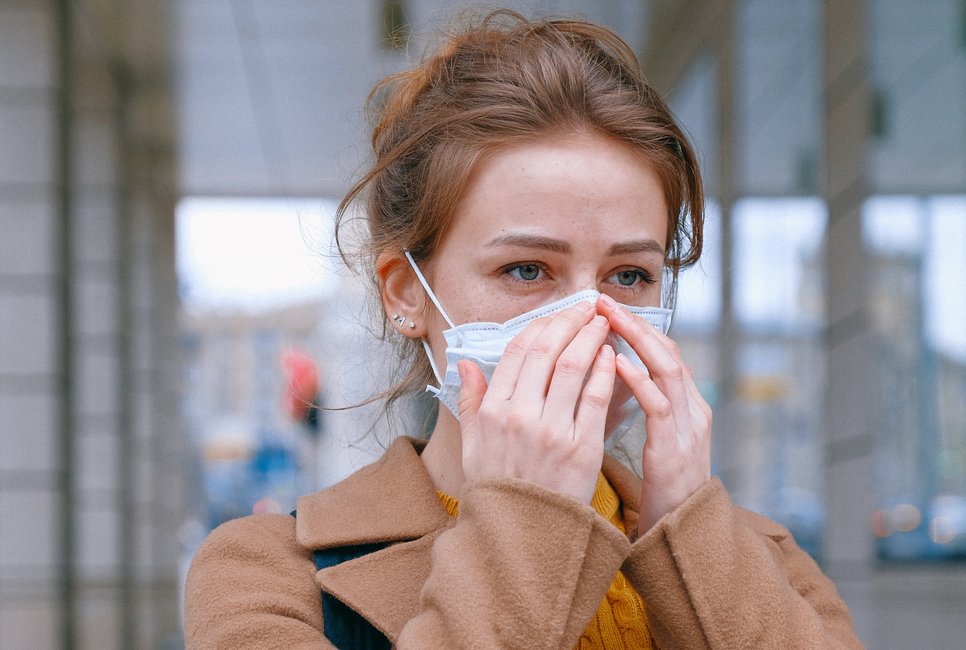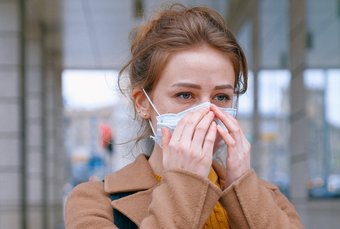Face masks effectively limit SARS-CoV-2 transmission
New study shows how face masks reduce the effective reproduction number of COVID-19, and why their efficacy varies between different environments under virus-limited and virus-rich conditions.
'Don't forget the mask' - although most people nowadays follow this advice, professionals express different opinions about the effectiveness of face masks. An international team led by researchers from the Max Planck Institute for Chemistry in Mainz, Germany, has now used observational data and model calculations to answer open questions. The study shows under which conditions and in which way masks actually reduce individual and population-average risks of being infected with COVID-19 and help mitigate the corona pandemic. In most environments and situations, even simple surgical masks effectively reduce the transmission of SARS-CoV-2 and the effective reproduction number for COVID-19. In environments with potentially high airborne virus concentrations such as medical settings and densely occupied indoor spaces, however, masks with higher filtration efficiency (N95/FFP2) should be used and combined with other protective measures such as intensive ventilation.

Face masks are among the most simple, easy-to-use, and effective measures against the airborne transmission of infectious respiratory diseases, but their usefulness against COVID-19 is still under debate. Some earlier investigations found that masks were apparently not effective under certain conditions. Others found high efficacies, but a conclusive explanation for the apparent contradictions and inconsistencies had not been given.
Researchers from the Max Planck Institute for Chemistry (MPIC), the Medical Center of the Johannes Gutenberg University Mainz, and the Charité – Universitätsmedizin Berlin together with partners from China and the USA used observational data and a novel quantitative model of airborne virus exposure to elucidate how the efficacy of face masks depends on characteristic regimes of airborne virus concentration.
In most situations, even simple surgical masks are effective
“For the airborne transmission of SARS-CoV-2, we find that usually just a minor fraction of exhaled respiratory particles contains viruses. Most environments and contacts are under virus-limited conditions, where face masks, including simple surgical masks, have a high efficacy in preventing the spread of COVID-19”, explains Yafang Cheng, the head of a Minerva Research Group at the MPIC. “Our study provides a detailed and novel mechanistic understanding of population-average mask efficacy, which explains why regions with a higher percentage of the population wearing masks have better control of the pandemic.”
In virus-rich indoor environments with high infection probability, however, more advanced masks (N95/FFP2) and other protective equipment are required to prevent airborne transmission. The strong dependence of mask efficacy on airborne virus concentration highlights the importance of combining masks with other protective measures such as ventilation and distancing to keep the infection probability low.
“The combination of high-efficiency masks with other protective measures is particularly important for hospitals, medical centers, and other indoor environments, where high risk patients may encounter high virus concentrations”, says Christian Witt, head of the Research Area Pneumology at the Charité – Universitätsmedizin Berlin. “Masks will remain an important protective measure against SARS-Cov-2 infection - even for vaccinated persons, especially when the protection provided by vaccination decreases over time.”
The approach can be used to assess protection against more infectious mutants
“Our approach and results of relating the effectiveness of protective measures to the infection probability and basic reproduction number are applicable to a wide range of respiratory viruses and diseases, including coronaviruses, rhinoviruses, and influenza. They can also be used to assess the efficacy of masks and other preventive measures against new and more infectious mutants of SARS-CoV-2.” says Hang Su, research group leader at the MPIC. “Our investigations also show that aerosol transmission does not necessarily lead to very high reproduction numbers as observed for measles, and that relatively low reproduction numbers do not rule out airborne transmission.”
Moreover, the study demonstrates how important high compliance and correct use of masks are to ensure their effectiveness in reducing the reproduction number of COVID-19. To reduce the reproduction number from ~3 as originally observed to below 1, at least 60-70% compliance would be required for surgical masks (~40% for N95/FFP2 masks). Higher rates of compliance would be required for more infectious variants of SARS-CoV-2, which re-emphasizes that masks should be combined with other protective measures like ventilation and distancing for efficient reduction of infection probabilities and reproduction numbers.
“Our study explains quantitatively why and how face masks are highly effective in virus-limited environments and less effective in virus-rich environments – both at the individual and the population average level related to observed infection rates and effective reproduction numbers. This has not been achieved before and is essential to overcome inconclusive earlier results, arguments, and discussions. We are confident, that the mechanistic insights and quantitative results gained in our study constitute a scientific breakthrough that will help to settle the ongoing debate about the usefulness of masks and promote efficient mitigation of the COVID pandemic,” summarizes Ulrich Pöschl, director of the MPIC Multiphase Chemistry Department.
